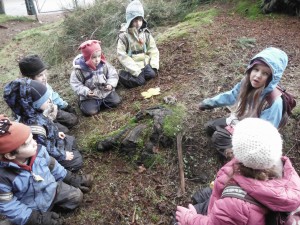 From the start we have focused on building respect, empathy and a community. With this foundation, we are focused on promoting interactions that foster care taking within the group and the environment that surrounds us.
From the start we have focused on building respect, empathy and a community. With this foundation, we are focused on promoting interactions that foster care taking within the group and the environment that surrounds us.
An example of how this happens throughout the day starts with a child noticing and checking on a friend who is sitting by himself. That child then takes it further and asks if is ok, what they can do to help and then sits with him until the problem is resolved. Another example is a child getting a tissue from their own bag for a friend who is upset and then inviting them to play. They encourage and teach each other constantly. One child was having a difficult time climbing up a tree and another child said “Just take your time, that’s how I got good; if you hold up here you can pull yourself up higher. But it is hard because it is slippery”. They notice what each other are doing and want to help out. One day a child was saving sticks for another child because she knew he was building a castle. When one child is trailing behind, another will notice, wait and walk with them until they catch up. They also help keep each other safe. One morning a child told another who was lifting a very large branch “I think you should put that down, that big stick isn’t safe”.
We foster a lot of self regulation skills and we are constantly watching children helping each other self regulate. One child was getting very silly so another child went and gently placed her hand on that child’s head and whispered “stop and think”. This is a tool we have given them, we will often tell them to stop and touch their own heads and think about what they are doing. This little girl noticed that the other child hadn’t mastered this yet, so she helped him. Sure enough he touched his head and replied “Oh, ya” and then put down the rock, took a breath and carried on his way. You can guarantee if one child falls in the forest all twenty children will be there to help them up and make sure they are alright. This is something Lisa and I have focused on, and we attribute a lot of our success to the amount of time we spent on building a community of learners. A positive outcome from this is that they truly are a community of learners working in collaboration to create meaning and grow together.
This carries through to nature in many ways. They are always looking for garbage, and things that don’t belong in the forest. They know and will remind each other not to pick living things and are becoming aware of their impact in the forest. We don’t bring anything back with us from nature, and the children will tell you that it is because it belongs to nature and the creatures of the forest.
Recently the children discovered an owl that was no longer living sitting up on a rock. Having been interacting with the idea of living and non living things, the children understood pretty well what this meant. They sat with this owl for a few minutes every day for a week, learning about what kind of owl it was, why it was there, how it got here and what would happen to it next. The day that left the biggest impact was not the day we researched the owl but the moment the children’s respect and empathy for the owl shined though. This was the moment they decided to make a circle around it and each say something nice to the owl. “We care about you” one child said, another offered “I hope you had a nice life”. Another child told the owl it was beautiful while another sang it a song. These children are becoming emotionally and spiritually connected to this forest and have taken ownership over its well being. They can identify and name the invasive species and see human impact including their own. Care taking is such a simple thought, but is embedded in much of the daily interactions in Nature Kindergarten.
(Written by Erin Van Stone, Nature Kindergarten ECE)







I will be in Victoria for the Ann Pelo evening at UVic with a colleague (maybe two) and we we hoping to visit your nature Kindergarten on Friday before heading back to Nanaimo. Are we able to book a tour? Thank you